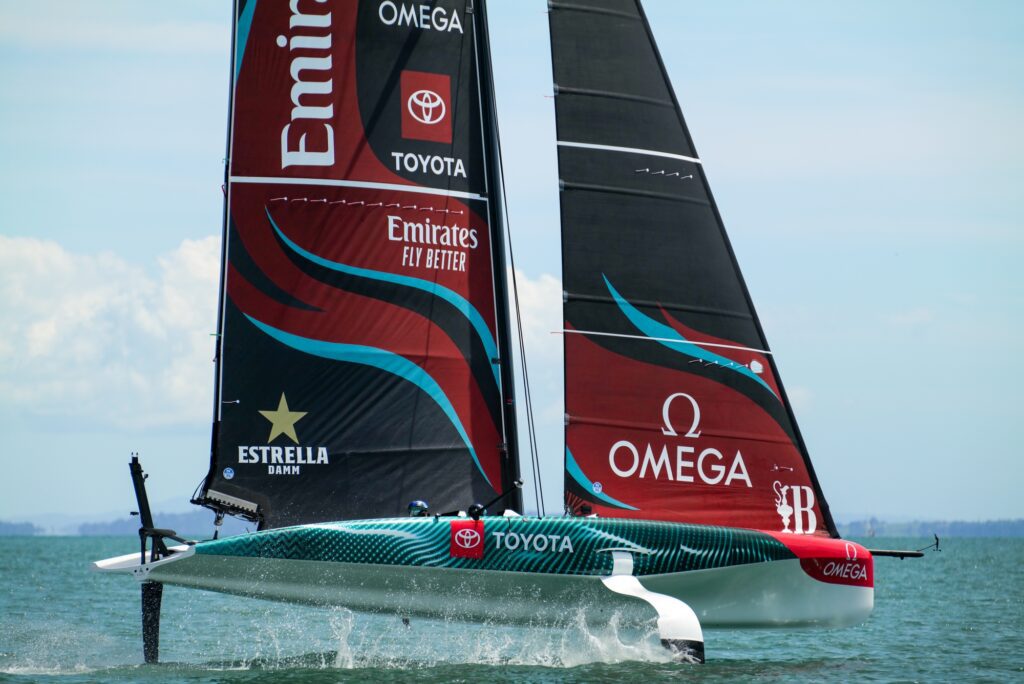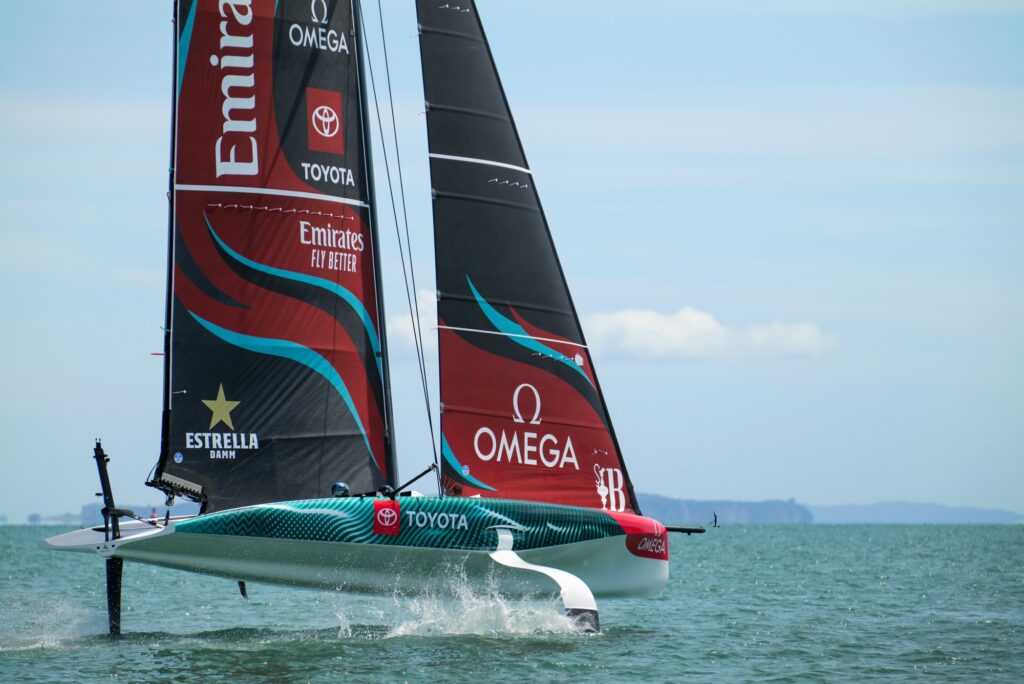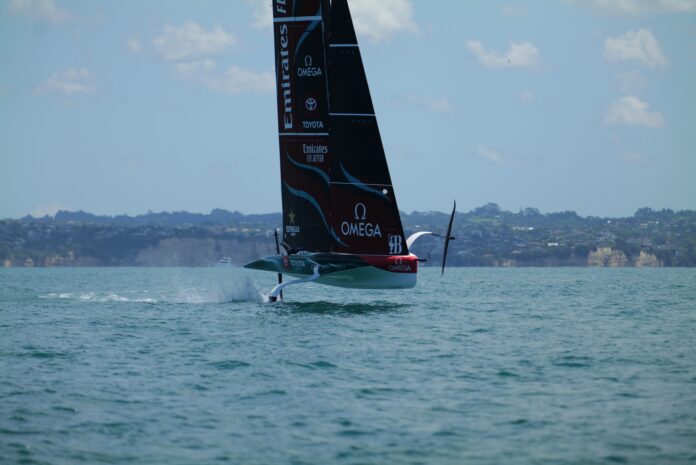The blue ensign of the New Zealand national flag, set high on the Auckland Harbour bridge, was a mere limping droop today as Emirates Team New Zealand docked-out at 11.30am for a down-range foil-testing session that was, in a lot of ways, remarkable.

Running the asymmetric foil set up with the more slender Wing 03 on starboard and the aggressive, progressive, voluminous elliptical design on the port foil arm, it was a day of low-speed work concentrating on take-offs and flow build.
What we appear to be seeing, both at the upper end and now the lower end is a slightly adapted foiling style with the Kiwis appearing to ‘stand’ more on the foils, even inducing leeward heel at times and keeping what looks like maximum hull leverage (pressure) onto the foil itself.

The International Moth-style windward heel that Emirates Team New Zealand were almost certainly the first team to perfect along with NYYC American Magic is still used in flight upwind but at a more nuanced rake as the team play with something rather different and the results, judging from today, are increasingly impressive. Rarely do they now cant wide and allow the foil tips to break the surface – presumably in an attempt for 100% foil flow efficiency – and it’s something that everyone will be looking at and dissecting over the coming weeks.

After some initial tow-to-fly exercises in sub 9 knot conditions and patchy harbour breeze, the sailing team found some breeze consistency and made low speed take-offs a priority, attaining flight with relative ease – particularly on the port foil with its increased wing volume.
What followed was a succession of high percentage foiling-success tacks and gybes, executed with the usual coaxing accuracy that the team have built into their smooth sailing style. Interesting to watch the team immediately post transition either through the tack or gybe with the hull just dropping momentarily before the flow attaches securely on the new foil and the tweaks to the mainsail just gliding the boat through.

Today was a long one with over four hours on the water and all under the watchful eye on the data analysts and performance engineers of whom, Elise Beavis, is one of the key interlinks between the sailors and the designers.
Speaking afterwards, Elise gave her usual outstanding interview that is always worth listening to. Talking about the early analysis of the foils, Elise commented: “I think they’re generally lining up with what we expected sort of through the range but it’s really good with these test foils to actually check in and see how they’re going, and you know that all carries through into the race foils for the big boat.”

The interview then delved into the whole scaling issue of testing components on AC40s rather than LEQ12, and Elise responded: “The AC40’s whole scaling that was done was all based off the V2 AC-75 so that’s why there’s only four crew and the hulls are actually shorter than they should be. They’re only 12 metres long because otherwise the rigs and the foils and stuff would all be scaled down further, and people don’t scale that well, so that’s why the forestay on the 40’s a lot closer to the bow than on the big boats and the transom’s kind of chopped off a bit but then the hull’s in the air, it’s really holding the sail package up and it’s holding the foils under the water so that doesn’t matter so much in terms of the testing.”

And asked about the merits of teams like INEOS Britannia and Luna Rossa Prada Pirelli building their own dedicated LEQ12, Elise gave an interesting answer, saying: “I guess for us with the AC40, because we designed it that meant that we went through this whole design, engineered the hull structure, sail design, foil design and all the one design concepts. So, as a team, the design team went through that process of coming up with all that design which I guess if you’re another team that just bought an AC40 and didn’t build your own LEQ hull you don’t go through that complete process. So yeah those teams that did build an LEQ that meant they got to kind of practise in-house going through the whole process, but we got that anyway with the AC40.”

Emirates Team New Zealand conclude a profitable week that’s seen pretty much a full range of testing conditions in the antipodean summer where New Zealand is famous for ‘four seasoins in one day.’ They looked sublime in the heavy air, as they always do, but today they proved that down-range, they’re pretty potent too. (Magnus Wheatley)
On-Water Recon Report – Emirates Team New Zealand: Low end conditions with a light sea breeze from the North prevailed today on day 59 of LEQ 12 testing out on the Hauraki Gulf for Emirates Team New Zealand. With the two new foils equipped, and the M2 main and J2 Jib hoisted, today’s plan seemed to be finding and sailing in the lower end of the breeze spectrum. The team hoisted sails off of Narrow Neck beach out in the channel between Rangitoto and the North Shore. The team then commenced sailing in a wind speed of no more than 9 knots, we estimated between 7.5 and 8.5 knots with the nearest wind station registering a mere 8.2 knots. In the past, we typically would have seen a tow-take-off in these conditions, however the new port foil proved to be more than capable of getting the yacht foiling. Later in the session we saw impressive light wind low speed take-offs on both foils. These foils proving today to be far more efficient in the light air than the previous foils from what we were seeing.

The team then sailed a long upwind towards Tiritiri Matangi, attempting many tacks in the light air. The conditions were marginal foiling even in a straight-line all day, but the team managed to successfully complete 32 of 43 tacks as full foiling, 4 touch and go and 7 full touch downs over the course of today’s session. Once up near Tiri, the team came off the foils due to lack of wind. A couple of tow attempts were tried on each tack with some glide stops maybe to test low end speed foiling capabilities. After these tests the team then long towed downwind for a kilometre or so until there was enough breeze to continue sailing downwind and so they cut the tow.
The team sailed a long downwind with a few turn ups on the way before eventually arriving back down near Rangitoto Light House for a couple of light air pre starts. Again, impressive light air manoeuvres could be seen throughout the day, with 30 out of 31 gybes being foilers and only one touchdown recorded all day.
Not much could be taken from the two pre starts, fairly standard manoeuvring and killing time at the boat end of the box, a little late speed/time kill on approach then starting near the boat.
After these starts the team slowly made their way again downwind before eventually heading back towards the base after what was a long session of sailing for ETNZ, nearly four hours in the LEQ12. Typically, we are used to sessions being around three hours.
It was definitely apparent the team were concentrating on finding the bottom end of these new foils in all aspects of the session today including take-offs, tacks, gybes, glides and even pre-starts. One comment today even in the light air in straight line moding, we again did not see a lot of windward heel on these foils with piercing kept to a minimum. With the flatter sea state, we did observe a little more bow down at times on the upwinds, however. As noted earlier, the low wind take-offs were one of the most impressive takeaways from today. Hopefully we can record an accurate take-off speed by paralleling the team over the next few sessions.






